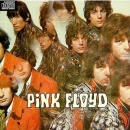Music Home / Entertainment Channel / Bullz-Eye Home
 Buy your copy from Amazon.com
Buy your copy from Amazon.com
| Pink Floyd: The Piper at the Gates of Dawn Released: 1967 |
You can thank Pink Floyd for the psychedelic colored-slides-and-lights experience when it came to live shows in the trippiest parts of the ‘60s. Thank them for it and then turn around and berate all other groups who decided to go that route as well. There were many of them and you know who they are. Thank Pink Floyd for all that, and thank them for also having rock’s first acid casualty in lead member Syd Barrett. After all, he was already getting majorly fucked up on LSD just when other people were just starting to turn on. And before you knew it, the guy was ousted from the group for his unhinged detachment from all his trips.
But before that, the Floyd managed to slip out two brilliant singles (“Arnold Layne” and “See Emily Play”) and their debut album The Piper at the Gates of Dawn. For many fans, this was a fantastic debut and remains as such. To my ears, though, it’s only ever been average. Barrett’s lyrical pursuits always seemed slight for the most part, and the almost twee folk pop style in which they were delivered never really seemed to gel with the other things the group was aiming for, be it psychedelic experimentation or an all-out rock sound. There are some good bits on it, but I always preferred A Saucerful of Secrets from the early Floyd era.
For whatever reasons, both “Arnold Layne” and “See Emily Play” had this energy about them that seems to get diluted on the album. Piper starts with the great “Astronomy Domine,” an instrumental that could very well be the epitome of “space rock” itself. It then dashes into “Lucifer Sam,” the best of all the lyrical songs about a freaky feline, no doubt induced by acid and Barrett’s own mind slipping at the time. The feel of the tune at its “That cat’s something I can’t explain!” refrain echoes “Free games for May / See Emily play” from the earlier single in style and energy.
“Matilda Mother” has an awkward coffee house feeling running underneath it, even while the band gets completely freaky in loud bursts throughout. It’s almost like “The Sounds of Silence” on acid. Not necessarily a good thing. Then there’s the happy-go-lucky stoned essence of “Flaming,” whose goofy melody has always left something to be desired. It almost sounds like a paint-by-numbers take on how to be the freshly reborn and wide-eyed acid head replete with its goofy lyrics about unicorns and buttercups. Blargh.
On the other hand, there’s the complete freakout of “Pow R Toc H” that still has to be heard to be fully appreciated (and that no amount of textual description can fully present in a coherent form). Yet “Take Up Thy Stethoscope and Walk” sounds like it was molded after the mod Who with a whole lot of really bad organ thrown on top. The Floyd were trying a bit of everything, and not all of it stuck so well. Even the psychedelic breakdown of the lengthy and classic “Interstellar Overdrive” is more annoying than sitting through the long version of the Doors’ “Light My Fire” and having to be dragged through that godawful Ray Manzarek organ solo.
Things get back to tweeland with “The Gnome” and its main character Grimble Gromble. It’s not a half-bad Barrett tune, especially when backed with “Chapter 24,” which was inspired by the I Ching. At this point it felt like the Floyd were better at being freaky when they turned down the wow factor and just let the songs breathe on their own. Of course, too little can be as bad as too much, and that’s exactly where “The Scarecrow” stands, with Nick Mason’s percussive bits that sounds like horses’ hooves clip-clopping and that godforsaken Mellotron bleating out of nowhere.
Piper closes with the fan favorite “Bike.” I remember the first time I heard the song was on the Relics album and it struck me as just dumb. It still does. Then again, I’ve never shied away from the fact that I liked the Floyd more after Syd was kicked out and David Gilmour was brought in and had his blues thing going on to balance out the psychedelic noodling of the early stuff. Yet this album shall always remain a classic, no matter what, due to Syd Barrett’s legions of fans. As time rolls on, though, the whole thing sounds more like a quaint curio than a seriously iconic piece of work.
jthompson@bullz-eye.com






